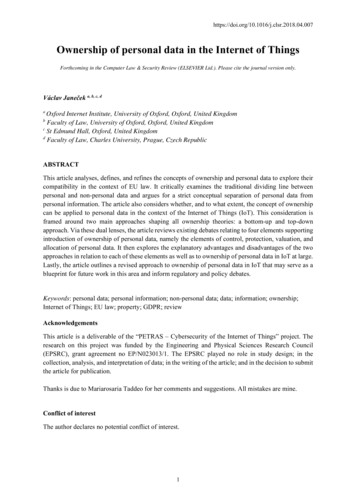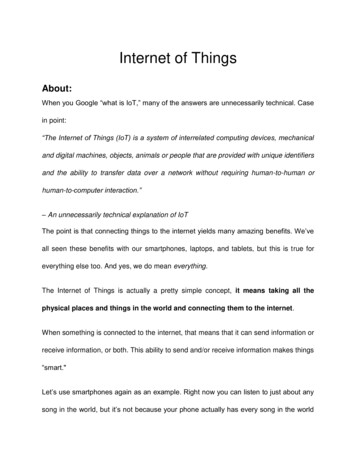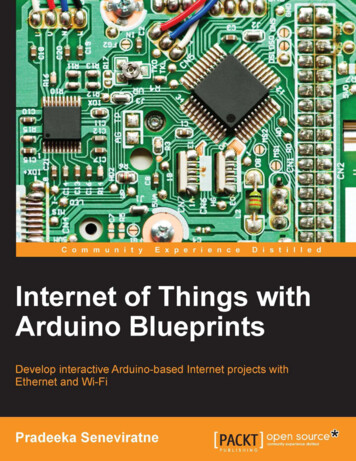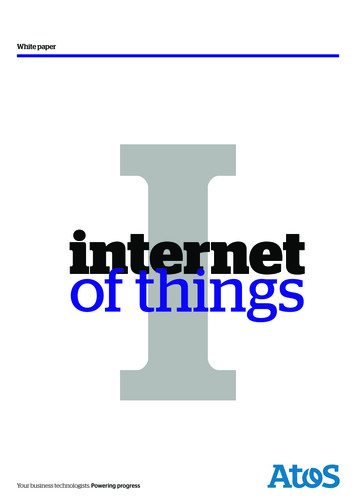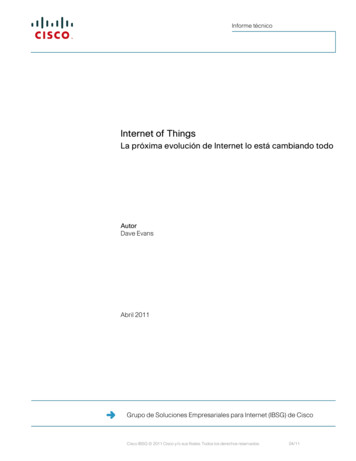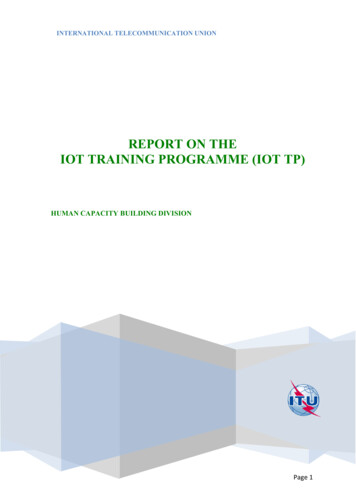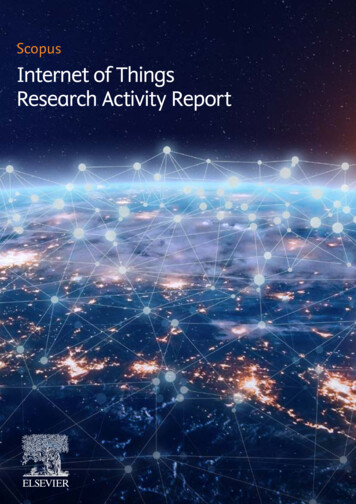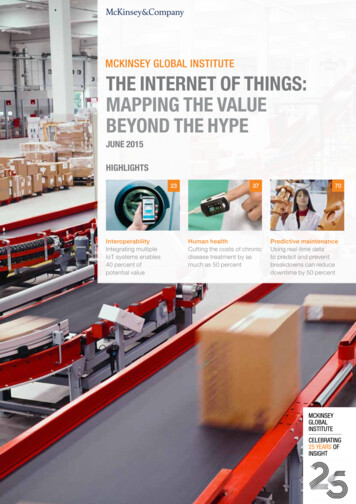
Transcription
THE INTERNET OF THINGS:MAPPING THE VALUEBEYOND THE HYPEJUNE 2015HIGHLIGHTS23InteroperabilityIntegrating multipleIoT systems enables40 percent ofpotential value37Human healthCutting the costs of chronicdisease treatment by asmuch as 50 percent70Predictive maintenanceUsing real-time datato predict and preventbreakdowns can reducedowntime by 50 percent
In the 25 years since its founding, the McKinsey Global Institute (MGI) has sought to developa deeper understanding of the evolving global economy. As the business and economicsresearch arm of McKinsey & Company, MGI aims to provide leaders in commercial,public, and social sectors with the facts and insights on which to base management andpolicy decisions.MGI research combines the disciplines of economics and management, employing theanalytical tools of economics with the insights of business leaders. Our “micro-to-macro”methodology examines microeconomic industry trends to better understand the broadmacroeconomic forces affecting business strategy and public policy. MGI’s in-depth reportshave covered more than 20 countries and 30 industries.Current research focuses on six themes: productivity and growth, natural resources, labormarkets, the evolution of global financial markets, the economic impact of technology andinnovation, and urbanization. Recent reports have assessed global flows; the economies ofBrazil, Mexico, Nigeria, and Japan; China’s digital transformation; India’s path from povertyto empowerment; affordable housing; and the effects of global debt.MGI is led by three McKinsey & Company directors: Richard Dobbs, James Manyika, andJonathan Woetzel. Michael Chui, Susan Lund, and Jaana Remes serve as MGI partners.Project teams are led by the MGI partners and a group of senior fellows, and includeconsultants from McKinsey offices around the world. MGI teams draw on McKinseypartners and experts. Leading economists, including Nobel laureates, serve as MGIadvisers. The partners of McKinsey & Company fund MGI’s research; it is not commissionedby any business, government, or other institution. For further information about MGI and todownload reports, please visit www.mckinsey.com/mgi.McKinsey Telecommunications, Media, and High Technology PracticeThe McKinsey Telecommunications, Media, and High Technology (TMT) Practice wasestablished to better address the convergence and synergies in these three sectors.The TMT Practice serves clients around the world in all areas of the TMT industry. ThePractice has deep functional expertise in capability-building and transformation, productdevelopment, operations, network technology, IT purchasing, and supply chain, as wellas customer lifecycle management, pricing, branding, distribution, and sales. TMT hasdeveloped perspectives on how new business models and disruptive technologies influencethese industries.McKinsey Business Technology OfficeThe Business Technology Office (BTO) serves clients in all sectors on top technologyissues facing their executives, helping them understand the long-term technological forcesimpacting their businesses. BTO develops IT strategies that are tightly aligned to businessgoals, uses technology to digitize business processes, and designs correspondingorganization and governance approaches. We also optimize our clients’ enterprisearchitecture, infrastructure, and applications management.Copyright McKinsey & Company 2015
THE INTERNET OF THINGS:MAPPING THE VALUEBEYOND THE HYPEJUNE 2015James Manyika San FranciscoMichael Chui San FranciscoPeter Bisson StamfordJonathan Woetzel ShanghaiRichard Dobbs LondonJacques Bughin BrusselsDan Aharon New York
PREFACEBy blending physical and digital realms, the Internet of Things (IoT) vastly expands the reachof information technology. The myriad possibilities that arise from the ability to monitor andcontrol things in the physical world electronically have inspired a surge of innovation andenthusiasm. The sweeping changes that IoT can bring to how companies manage physicalassets, how consumers attend to their health and fitness, and how cities operate have alsoinspired visions of a very different future, as well as a good deal of hype. McKinsey has beeninvolved in the Internet of Things over the years and we have seen how rapid advances intechnology and know-how have exceeded our expectations—and yet how difficult it will beto obtain the greatest benefits of IoT implementations, which require creating highly complexsystems and coordinating technology, investment, and talent across both space and time.This research is a collaboration between the McKinsey Global Institute and McKinsey’sTelecommunications, Media, and High Technology Practice. It builds on more thanfive years of previous research as well as knowledge developed in work with clients acrossindustries. Our goal has been to determine more clearly how IoT applications create valuefor companies, consumers, and economies. To distinguish between the hype and thereality, we focus on actual “use cases” that exist today or are likely to be implemented inthe next 10 years. We also estimate potential value using a “settings” perspective—how IoTtechnology is used in physical environments such as cities or factories. This allows us to seehow much additional value can be captured when IoT applications interact with one anotherand with other information systems.MIchael Chui, an MGI partner, James Manyika and Jonathan Woetzel, MGI directors,and Peter Bisson, director of McKinsey’s TMT Practice in North America, led this effort.Dan Aharon led the research team, which included Wei-Chuan Chew, Krishna Esteva,Vasanth Ganesan, Faheem Kajee, and Saurabh Mittal. We are grateful for the generouscontributions of time and expertise from McKinsey colleagues from many practices andfunctions, including members of the Business Technology Organization (BTO). We thankMGI Director Richard Dobbs, and McKinsey Directors Jacques Bughin, Tor Jakob Ramsøy,and Dilip Wagle. Geoffrey Lewis provided editorial support and Julie Philpot led productionwith Marisa Carder, senior graphic designer. We also thank MGI external communicationsdirector Rebeca Robboy, Tim Beacom (knowledge operations specialist), andDeadra Henderson (manager of personnel and administration).McKinsey colleagues Bede Broom, Greg Gilbert, Saum Sutaria, Jordan Van Laer,and Sri Velamoor provided insight on human health. Venkat Alturi, Naveen Sastry,Jeremy Schneider, and Shekhar Varanasi helped with home and office settings.Taylor Larson, Dev Patel, Roger Roberts, and Khiloni Westphely provided input onretail environments. Jamie Cattell, Richard Kelly, Brian Milch, Sree Ramaswamy, andDominik Wee helped with factory settings (including hospitals). We thank Rocco Colazonte,Christopher Forr-Rydgren, Alex Liebman, Mukani Moyo, Frederic Remond,Richard Sellschip, and Richard Ward for their support on worksite industries (mining,oil and gas, and construction). Michele Bertoncello, Jürgen Müller, O Sung Kwon, andRobin Riedel gave insights about IoT in vehicles and outside settings. Our research on IoTin cities was aided by Adrian Booth, Shannon Bouton, Tyler Duvall, Sergio Martin Guerrero,Jürgen Laartz, Jaana Remes, and Mikhail Savkin. Kevin Boehler, Arvind Govindarajan,
Andreas A. Kremer, and Andrew Sellgren provided insights on credit risk. Senthil Muthiahand Mark Patel provided perspectives on the IoT technology value chain.We are also extremely grateful for the generous contributions of outside advisers.Our academic advisers were Matthew Slaughter, founding director, Center for GlobalBusiness and Government, Tuck School of Business, Dartmouth College; and Hal Varian,emeritus professor in the School of Information, Haas School of Business, University ofCalifornia, Berkeley. We also thank the industry experts whose insights helped shape thiswork: Tim O’Reilly, CEO, O’Reilly Media; Jane Sarasohn-Kahn, founder, Think-Health;Andrew Rosenthal, group manager: wellness and platform, Jawbone; Rick Scully, chiefexecutive, Remote Health Associates; and Tamara Wexler, director of the NYU LangoneMedical Center Pituitary Center.This report contributes to MGI’s mission to help business and policy leaders understandthe forces transforming the global economy, identify strategic locations, and prepare for thenext wave of growth. As with all MGI research, this work is independent and has not beencommissioned or sponsored in any way by any business, government, or other institution.We welcome your comments on the research at MGI@mckinsey.com.Richard DobbsDirector, McKinsey Global InstituteSeoulJames ManyikaDirector, McKinsey Global InstituteSan FranciscoJonathan WoetzelDirector, McKinsey Global InstituteShanghaiJune 2015
Alamy
CONTENTSHIGHLIGHTSIn brief35Executive summary Page 1The hype has been great—the value may be greater1. Introduction Page 17The power of digitizing the physical worldOperations optimization372. Findings Page 23Interoperability is key; most data are not used today3. How IoT applications create value in different settingsHumanHealth and fitnessHome50Page 37Page 50Retail environmentsOfficesHome automationPage 63FactoriesPage 66WorksitesPage 74VehiclesCitiesOutsidePage 56Page 82Page 87Page 954. Enablers and barriers Page 101Technical and human issues must be addressed5. Implications Page 109New business models and a new tech marketBibliographyPage 127Page 35
IN BRIEFTHE INTERNET OF THINGS:MAPPING THE VALUEBEYOND THE HYPEThe Internet of Things—digitizing the physical world—has received enormous attention. Inthis research, the McKinsey Global Institute set out to look beyond the hype to understandexactly how IoT technology can create real economic value. Our central finding is that thehype may actually understate the full potential of the Internet of Things—but that capturingthe maximum benefits will require an understanding of where real value can be created andsuccessfully addressing a set of systems issues, including interoperability. Viewing IoT applications through the lens of the physical settings in which these systemswill be deployed creates a broader view of potential benefits and challenges. Rather thanjust analyzing IoT uses in vertical industries, we also look at settings, such as cities andworksites. This shows how various IoT systems can maximize value, particularly whenthey interact. We estimate a potential economic impact—including consumer surplus—ofas much as 11.1 trillion per year in 2025 for IoT applications in nine settings. Interoperability between IoT systems is critically important to capturing maximum value;on average, interoperability is required for 40 percent of potential value across IoTapplications and by nearly 60 percent in some settings. Most IoT data are not used currently. For example, only 1 percent of data from an oil rigwith 30,000 sensors is examined. The data that are used today are mostly for anomalydetection and control, not optimization and prediction, which provide the greatest value. Business-to-business (B2B) applications can create more value than pure consumerapplications. While consumer applications such as fitness monitors and self-driving carsattract the most attention and can create significant value, we estimate that B2B uses cangenerate nearly 70 percent of potential value enabled by IoT. There is large potential for IoT in developing economies. Over the next ten years, weestimate higher potential value for IoT in advanced economies because of higher value peruse. However, nearly 40 percent of value could be generated in developing economies. Customers will capture most of the benefits. We estimate that the users of IoT (businesses,other organizations, and consumers) could capture 90 percent of the value that IoTapplications generate. For example, the value of improved health of chronic diseasepatients through remote monitoring could be as much as 1.1 trillion per year in 2025. A dynamic industry is evolving around IoT technology. Like other technology waves,there are opportunities for both incumbents and new players. Digitization blurs the linesbetween technology companies and other types of companies; makers of industrialmachinery, for example, are creating new business models, by using IoT links and data tooffer their products as a service.To realize the full potential from IoT applications, technology will need to continue to evolve,providing lower costs and more robust data analytics. In almost all settings, IoT systems raisequestions about data security and privacy. And in most organizations, taking advantage ofthe IoT opportunity will require leaders to truly embrace data-driven decision making.
Where is the value potentialof the Internet of Things? 1% of data currently used,mostly for alarms or real-timecontrol; more can be used foroptimization and predictionInteroperabilityrequired to capture40% of total value2X more valuefrom B2B applicationsthan consumerVehiclesAutonomous vehicles andcondition-based maintenance 210B 740BDeveloping: 40%Developed: 60%HomeChore automationand security 200B 350BOfficesSecurity andenergy 70B 150B9 settingsCitiesPublic healthand transportation 930B 1.7Tgave us a cross-sector viewof a total potential impact of 3.9 trillion–11.1 trillionper year in 2025OutsideLogistics and navigation 560B 850BFactoriesOperations andequipment optimization 1.2T 3.7TRetail environmentsAutomated checkout 410B 1.2THumanHealth andfitness 170B 1.6TWorksitesOperations optimization/health and safety 160B 930BTypes of opportunitiesTransform business processesPredictive maintenance, better assetutilization, higher productivityEnable new business modelsFor example, remote monitoring enablesanything-as-a-service
Executive summary: Glasses man Getty Images
EXECUTIVE SUMMARYThe Internet of Things has the potential to fundamentally shift the way we interact with oursurroundings. The ability to monitor and manage objects in the physical world electronicallymakes it possible to bring data-driven decision making to new realms of human activity—tooptimize the performance of systems and processes, save time for people and businesses,and improve quality of life (see Box E1, “Defining the Internet of Things”). From monitoringmachines on the factory floor to tracking the progress of ships at sea, sensors can helpcompanies get far more out of their physical assets—improving the performance ofmachines, extending their lives, and learning how they could be redesigned to do evenmore. With wearable devices and portable monitors, the Internet of Things has the potentialto dramatically improve health outcomes, particularly in the treatment of chronic diseasessuch as diabetes that now take an enormous human and economic toll.Manufacturers, oil and gas companies, and otherbusinesses have already begun to see the initialpayoff from IoT technologies in their operations.A great deal has been written about the Internet of Things in the past five years, including byMcKinsey, which began publishing its research on the emerging technology in 2010.1 IoTenabled developments such as self-driving cars have captured the popular imagination, andwith fitness bands to monitor physical activity and Internet-connected devices to manageHVAC systems, appliances, entertainment, and security systems, consumers are getting aglimpse of what the IoT-enabled future may bring. Manufacturers, oil and gas companies,and other businesses have already begun to see the initial payoff from IoT technologies intheir operations. And technology suppliers are ramping up IoT businesses and creatingstrategies to help customers design, implement, and operate complex systems—andworking to fill the gap between the ability to collect data from the physical world and thecapacity to capture and analyze it in a timely way.1See, for example, “The Internet of Things,” McKinsey Quarterly, March 2010, and Disruptive technologies:Advances that will transform life, business, and the global economy, McKinsey Global Institute, May 2013.Box E1. Defining the Internet of ThingsWe define the Internet of Things as sensors and actuators connected by networks tocomputing systems. These systems can monitor or manage the health and actions ofconnected objects and machines. Connected sensors can also monitor the natural world,people, and animals.For the purposes of this research, we exclude systems in which all of the sensors’ primarypurpose is to receive intentional human input, such as smartphone apps where data inputcomes primarily through a touchscreen, or other networked computer software where thesensors consist of the standard keyboard and mouse.
We conducted this research to examine in detail how the Internet of Things can createvalue, and in the process we have uncovered novel findings about how that value can becaptured by companies, people, and economies. Building on our earlier work, the McKinseyGlobal Institute, in collaboration with McKinsey’s Telecommunications, Media, and HighTechnology Practice and the McKinsey Business Technology Office, analyzed morethan 150 IoT use cases across the global economy. Using detailed bottom-up economicmodeling, we estimated the economic impact of these applications by the potential benefitsthey can generate, including productivity improvements, time savings, and improved assetutilization, as well as an approximate economic value for reduced disease, accidents, anddeaths. These estimates of potential value are not equivalent to industry revenue or GDP,because they include value captured by customers and consumers.An important contribution of this research has been to demonstrate the importance ofanalyzing the applications of the Internet of Things in the context of settings—the physicalenvironments in which these systems are deployed, such as homes, offices, and factories.A key insight from analyzing the benefits of IoT applications within settings is the criticalcontribution made by interoperability among IoT systems. On average, interoperability isnecessary to create 40 percent of the potential value that can be generated by the Internetof Things in various settings. We also see that making IoT applications interoperable—linkinga patient’s home health monitor to the hospital’s health informatics system, for example—isa complex systems design challenge that requires coordination on many levels (technology,capital investment cycles, organizational change, and so forth.For the applications that we size, we estimate that the Internet of Things has a total potentialeconomic impact of 3.9 trillion to 11.1 trillion per year in 2025. On the top end, the valueof this impact—including consumer surplus—would be equivalent to about 11 percent ofthe world economy in 2025.2 Achieving this level of impact will require certain conditions tobe in place and overcoming technical, organizational, and regulatory hurdles. In particular,organizations that use IoT technology will need better tools and methods to extract insightsand actionable information from IoT data, most of which are not used today. It will taketime for companies to create systems that can maximize IoT value and, more importantly,for management innovations, organizational changes, and new business models tobe developed and implemented. This could lead to a new “productivity paradox”—alag between investment in technology and productivity gains that can be seen at amacroeconomic level.3 11TMaximum potentialvalue of sizedapplications in2025Determining the settings where the Internet of Things will create impactIn reviewing nearly 300 IoT applications, we discovered that using only a conventionalapproach to categorizing the potential impact by vertical industry markets—such asautomotive or consumer electronics—made it more difficult to analyze all the ways inwhich value could be created. If we look at how IoT technology is creating value from theperspective of the automaker, for instance, we would see how it improves manufacturingefficiencies and reduces costs. However, by viewing IoT applications through the lens ofsettings, we capture a broader set of effects, particularly those that require the interactionof IoT systems and often produce the greatest impact. For example, by examining thecities setting, we discover that not only can sensors in individual vehicles be used to save232Based on World Bank projection of 99.5 trillion per year in global GDP in 2025The productivity paradox was observed by economists Robert Solow and Stephen Roach, who in 1987 notedthat despite the widespread adoption of computers to automate office functions, there was no evidence oftheir impact on productivity. Subsequent research found problems in how government statistics measured theimpact of computers and a lag between investment in technology and the organizational adjustments requiredto realize significant productivity gains. See Erik Brynjolfsson and Lorin M. Hitt, “Beyond the productivityparadox,” Communications of the ACM, volume 41, issue 8, August 1998. See also US Productivity Growth1995-2000, McKinsey Global Institute, October 2001.McKinsey Global InstituteExecutive summary
maintenance costs by predicting when maintenance is needed but we also see that sensorscan be linked to broader systems that help to manage traffic congestion across the city.We have identified nine settings, capturing IoT use in environments such as homes, offices,factories, worksites (mining, oil and gas, and construction), retail environments, cities,vehicles, and the outdoors. We have also included a “human” setting for for systems thatattach to the human body and enable such health and wellness applications as monitoringchronic disease or exercise, and productivity-enhancing applications such as use ofaugmented-reality technology to guide workers in performing complex physical tasks(Exhibit E1).Exhibit E1A “settings” lens helps capture all sources of value; we identify nine settings where IoT creates valueSettingDescriptionExamplesHumanDevices attached to orinside the human bodyDevices (wearables and ingestibles) to monitor and maintainhuman health and wellness; disease management, increasedfitness, higher productivityHomeBuildings where people Home controllers and security systemsliveRetailenvironmentsSpaces whereconsumers engage incommerceStores, banks, restaurants, arenas—anywhere consumersconsider and buy; self-checkout, in-store offers, inventoryoptimizationOfficesSpaces whereknowledge workersworkEnergy management and security in office buildings; improvedproductivity, including for mobile tsPlaces with repetitive work routines, including hospitals and farms;operating efficiencies, optimizing equipment use and inventoryWorksitesCustom productionenvironmentsMining, oil and gas, construction; operating efficiencies, predictivemaintenance, health and safetyVehiclesSystems inside movingvehiclesVehicles including cars, trucks, ships, aircraft, and trains; conditionbased maintenance, usage-based design, pre-sales analyticsCitiesUrban environmentsPublic spaces and infrastructure in urban settings; adaptive trafficcontrol, smart meters, environmental monitoring, resourcemanagementOutsideBetween urbanenvironments (andoutside other settings)Outside uses include railroad tracks, autonomous vehicles (outsideurban locations), and flight navigation; real-time routing, connectednavigation, shipment trackingSOURCE: McKinsey Global Institute analysisMcKinsey Global InstituteThe Internet of Things: Mapping the value beyond the hype3
Overall findingsThrough our work studying individual use cases and estimating their potential economicimpact, we have developed insights into how the Internet of Things is likely to evolve.These findings include perspectives on how the potential benefits of IoT technologies arelikely to be distributed among advanced and developing economies, how much IoT valueis likely to be created in business-to-business vs. consumer markets, and which playersin the value chain will capture the most value from IoT applications. We find that when IoTsystems communicate with each other, their value is multiplied, which makes interoperabilityessential for maximizing benefits. Our research also generated findings about how theindustry that supplies IoT technology is likely to evolve. Our key findings: Interoperability among IoT systems is required to capture 40 percent of thepotential value. In our analysis, of the total potential value that can be unlocked throughthe use of IoT, 40 percent of this value, on average, requires multiple IoT systems to worktogether. In the worksite setting, 60 percent of the potential value requires the ability tointegrate and analyze data from various IoT systems. Interoperability is required to unlockmore than 4 trillion per year in potential economic impact from IoT use in 2025, out of atotal potential impact of 11.1 trillion across the nine settings that we analyzed. Most of the IoT data collected today are not used at all, and data that are usedare not fully exploited. For instance, less than 1 percent of the data being generatedby the 30,000 sensors on an offshore oil rig is currently used to make decisions. And ofthe data that are actually used—for example, in manufacturing automation systems onfactory floors—most are used only for real-time control or anomaly detection. A greatdeal of additional value remains to be captured, by using more data, as well as deployingmore sophisticated IoT applications, such as using performance data for predictivemaintenance or to analyze workflows to optimize operating efficiency. Indeed, IoT canbe a key source of big data that can be analyzed to capture value, and open data, whichcan be used by more than one entity.4 The amount of IoT value that can be realized in developing economies iscomparable to that of advanced economies. Overall, over the next ten years, moreIoT value is likely to be created in advanced economies because of the higher valueassociated with each deployment. However, the potential number of IoT uses is likelyto be higher in developing economies. The level of value in advanced and developingeconomies will vary depending on setting, industry, and application. The applicationsthat drive the most value in developing economies differ from those in advancedeconomies and, in some cases, because there are no legacy technologies to displace,developing economies can “leapfrog” in IoT implementations. Nevertheless, we estimatethat 62 percent of the potential annual economic impact of IoT applications in 2025 willbe in advanced economies and that 38 percent will be in developing economies. Thehigher value in advanced economies reflects higher wage rates and costs, which raisethe economic value of increased efficiency (Exhibit E2). As the values in developingeconomy markets rise, the economic impact associated with IoT also will grow.The high volume of estimated installations in developing economies reflects the shift ofglobal economic growth to those areas, which has important implications for companiesthat compete in IoT equipment and service markets. China will be one of the largestusers of IoT systems in factories as well as in other settings. Countries with oil andgas operations—among the most important early adopters of IoT—will also be majorgeographic markets.44See Big data: The next frontier for innovation, competition, and productivity, McKinsey Global Institute, May2011, and Open data: Unlocking innovation and performance with liquid information, McKInsey GlobalInstitute, October 2013.McKinsey Global InstituteExecutive summary
Exhibit E2More value from IoT could be created in advanced economies, but the number of deploymentscould be higher in the developing worldAdvanced%DevelopingReasons for different levels of e spending in advancedeconomies is twice that in developingeconomiesHigher values in advanced economiesoutweighs higher number of emergingmarket householdsHigher adoption and values in advancedeconomies, but large number of retailsettings in developing marketsHigher costs and wages in advancedeconomies raises value of impactLarger investments in automation inadvanced economies but large numberof factories in emerging marketsHigher adoption in advanced economiesoutweighs larger number of developingeconomy deploymentsVehicles6337Higher costs in advanced economiesCities6238More autonomous vehicles in advancedeconomies, but larger number of citiesand populations in developing markets56Outside62Total44Transportation/shipping spending higherin advanced economies38NOTE: Numbers may not sum due to rounding.SOURCE: McKinsey Global Institute analysis B2B applications of IoT have greater economic potential than consumerapplications. Consumer uses of IoT technology have garnered a great deal of attention,thanks to media coverage of fitness monitors and home automation. While theseapplications do have tremendous potential for creating value, our analysis shows thatthere is even greater potential value from IoT use in business-to-business applications. Inmany instances, such as in worksite applications (mining, oil and gas, and construction),there is no direct impact for consumers. A great deal of additional value can be createdwhen consumer IoT systems, such as connected consumer health-care products, arelinked to B2B systems, such as services provided by health-care providers and payors.McKinsey Global InstituteThe Internet of Things: Mapping the value beyond the hype5
Users of IoT technologies will capture most of the potential value over time. Asin other technology markets, the end customer ultimately captures the most value, wefind. Eventually, we estimate that customers (such as factory owners using machinesguided by IoT technology, operators of transportation fleets, and consumers) will captureupwards o
MAPPING THE VALUE BEYOND THE HYPE The Internet of Things—digitizing the physical world—has received enormous attention. In this research, the McKinsey Global Institute set out to look beyond the hype to understand exactly how IoT technology can create real economic value. Our central finding is that the hype may actually understate the full .



